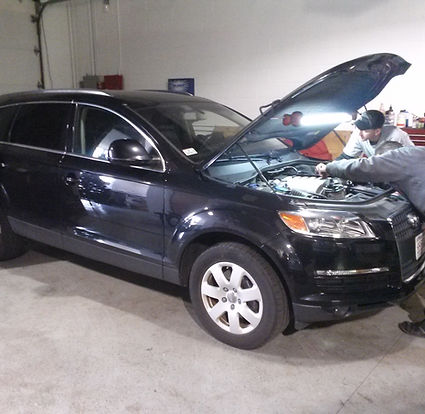
Vehicle Maintenance Inspections
Follow your vehicle maintenance schedule and car manufacturer service intervals. The Driveway Doctors and our mobile mechanics will keep your car's scheduled maintenance on track.
The High Incidence of Car Maintenance Neglect -
Motorists are keeping their vehicles longer than ever before, but they are also not maintaining their cars properly, according to latest surveys.
These are the items that are usually neglected:
the engine oil, brake fluids, transmission fluids, the engine coolant, power-steering fluids, washer fluids, windshield wipers, belts, hoses, air filters, the check engine light, tire pressure, tire depth, brake lights, head lights, and, cables, clamps or terminals.

Engine Air Filter Maintenance -
The engine-air filter keeps dirt out of the engine, so its service life depends on its operating environment. A motorist who do a lot of driving on rural gravel roads may need a new filter every couple of months, while a city dweller might go a year or more between changes. To assure a proper fit, make sure that the old air filter and the new one are the same height and size. If the filter does not fit properly, unfiltered air may leak past it. Another item needed is a PCV breather filter which is located inside the air cleaner housing. This filter should be replaced if a new Positive Crankcase Ventilation PCV valve is being installed. Another filter is the cabin-air filter which cleans the air that enters the passenger compartment. The filter's service life depends on its construction (dust only or dust and odor), and operating conditions. Dust only filters should be changed every couple of years, while dust/odor filters should be replaced yearly.
Fuel Filter Maintenance -
For reliable engine operation and fuel system performance, a clean fuel supply is essential. The fuel filter is the fuel system's primary line of defense against dirt, debris and small particles of rust that flake off the inside of the fuel tank. If not trapped by the filter, contaminants can plug fuel metering orifices in a carburetor or prevent valves from seating. In fuel injected engines, fuel debris can clog the injector inlet screens and starve the injector for fuel. And if debris gets inside the injector, it can wear or jam the pintle valve and seat. The typical recommendation today for a fuel filter replacement is every 30,000 miles, but many technicians say yearly fuel filter changes can reduce the risk of dirty fuel-related problems.
Engine Oil Maintenance -
The motor oil not only lubricates the engine, but also cools, cleans and protects it. The oil itself can't do all of these jobs without some help. Half a pint of various additives are added to the typical quart of oil to improve its ability to resist heat, friction, oxidation and contamination.
Short-trip driving is hard on oil because the engine never warms up enough to boil off the moisture that accumulates inside the crankcase. The moisture comes from combustion gases that blow by the piston rings. Older engines have greater amounts of blow-by. Most gases are removed by the Positive Crankcase Ventilation (PCV) system. But in a cold engine, much of the moisture condenses and ends up in the oil. Water reacts with oil to form sludge and acids. This results in accelerated engine wear. The filter can only remove suspended solids such as dirt, carbon and metal particles -- not moisture, acids or sludge. The only way to get rid of the accumulated moisture, acids and sludge is to change both oil and filter on a regular basis.
Oil Filter Maintenance -
An engine's main line of defense against abrasion and the premature wear is the oil filter. The oil filter removes solid contaminants such as dirt, carbon and metal particles from the oil before they can damage bearing, journal and cylinder wall surfaces in the engine. The more dirt and other contaminants the filter can trap and hold, the better. All the oil that is picked up by the oil pump is routed through the filter, before it goes to the crankshaft bearings, cam bearings and valve train. This is called "full-flow" filtration. In time though, accumulated dirt and debris trapped by the filter begin to obstruct the flow of oil. The filter should be changed before it reaches this point because if the bypass valve is forced open, unfiltered oil will go to the engine. A new oil filter is a cheap insurance against premature engine wear.
Automatic Transmission Maintenance -
Automatic transmission fluid is rarely changed for preventive maintenance, yet is often the cause of premature-transmission failure. Considering how expensive a transmission is to replace, the cost of changing the fluid and filter periodically is inexpensive. Most owners' manuals do not specify a change interval for automatic transmission fluid unless the vehicle is used for towing. The vehicle manufacturers say their fluids can go upwards to 100,000 miles under normal driving conditions. Yet most experts say regular transmission fluid and filter changes every 25,000 to 30,000 miles can significantly prolong the life of the transmission. But if a transmission has a lot of miles on it and the fluid has never been changed, they also say it may be best to leave the fluid alone. Why? Because changing the fluid may loosen accumulated varnish deposits that could cause sticking of control valves in the valve body.
At the very least, the transmission fluid level should be checked periodically. This should be done after the vehicle has been driven and the fluid is hot. The dipstick is then read while the engine idling and the transmission is in park. If the level is low, fluid should be added to gradually bring the level up to the full mark, but do not overfill. If the transmission is leaking fluid from the pan gasket or rear seal, these parts are difficult or expensive to replace.
Cooling System Maintenance -
The antifreeze in the coolant performs three very important jobs: it prevents the coolant from freezing during cold weather; it raises the boiling temperature of the coolant to prevent overheating during hot weather; and it fights corrosion. Check the level of the coolant periodically to make sure it isn't low (which usually indicates a leak).
Most car manufacturers recommend a 50/50 mixture of water and antifreeze for normal freezing and boil over protection. Up to a 70/30 mixture of antifreeze and water can be used to maximize freezing protection. Straight water or straight antifreeze should never be used in a vehicle's cooling system. Most car manufacturers recommend changing the “green” coolant every two to three years or 30,000 miles. Longer-lived “orange and yellow” coolants have a recommended service-life of 5 years or 150,000 miles. If the cooling system is dirty, use a flush (engine-coolant flush and refill service) to remove rust and scale.
Brake System Maintenance -
Brake fluid is another fluid that is usually neglected. The only time it is changed is when the brakes are relined (if then!). But it should be changed more often because brake fluid absorbs moisture over time. After two or more years of service, it can become badly contaminated with moisture. This lowers its boiling point and may contribute to pedal fade, if the brakes overheat. It also promotes internal rust and corrosion that can damage calipers, wheel cylinders and anti lock brake system components. Many experts say changing the fluid every three years prolong the life of the hydraulic components in the brake system and can improve safety. The fluid level should be checked periodically to make sure it is not low. The fluid level in the master cylinder will gradually drop as the brake linings wear, but a sudden drop usually means a leak and a possible loss of hydraulic pressure.
Power Steering Fluid Maintenance -
Like brake fluid, power steering fluid is hardly ever changed unless a hose fails or the steering gear has to be replaced. There is no recommended car maintenance service interval, but the fluid should be replaced if the pump or steering gear has failed and is also being replaced. The old fluid may contain debris that can damage a new steering pump and steering gear. It is also important to check the fluid level in the pump reservoir periodically (a low fluid level usually indicates a leaky hose or seal somewhere in the system). If fluid is needed, refer to the owner's manual for the type of fluid that is recommended.
The Most Common Car Maintenance Problems :
Dirty air filters are the most common car maintenance problem. Other common preventive maintenance problems include:
Low Tire Pressure - Tire pressure should be checked at least once a month to ensure tires are not under or over inflated. Tires pressure levels should match recommended levels in the owner's manual. Low pressure in the tires increases wear and fuel consumption. Having too much pressure may reduce traction. Keeping tires properly aligned will also help ensure longer tire life and improve fuel economy.
Worn Wiper Blades -Rigid, cracked or torn wiper blades can greatly reduce visibility when driving in rain and snow. Wiper blades should be examined and replaced once a year or sooner, if streaking occurs.
Low or Old Engine Oil - Old and dirty oil reduces engine protection and increases engine wear, while low oil levels can lead to overheating. If the oil level drops too low, lubrication will be lost and severe engine damage can result. Regular oil changes based on the owner's manual schedule will extend engine life.
Old Transmission Fluid - Changing automatic transmission fluid at the intervals recommended by the vehicle manufacturer will keep the vehicle shifting smoothly and extend the life of the transmission. Take your vehicle to a shop for a transmission flush to exchange new fluid for the old. This does a much more complete job than a simple drain and fill.
Low Coolant Level and Weak Antifreeze - The coolant level should be maintained at the full mark on the reservoir, and the strength of the antifreeze should provide freezing protection down to -25° Fahrenheit.
Worn Tires - Minimum tread depth should be 3/32 inch. Tires should be replaced if the wear bars are flush with the surface of the tread.




